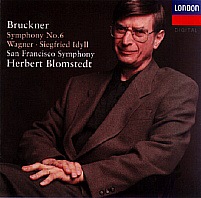
The Blomstedt Years, Part 1
I have begun — rather foolishly, I fear, without having cased out the territory before setting forth — a survey of the San Francisco Symphony's rich discography. I devoted my initial article to the beloved Pierre Monteux, who piloted the SFS through many palmy years as an RCA Victor stalwart.
Since Monteux's time, numerous captains have stood the helm of the symphony's ship of state: Enrique Jorda, Joseph Krips, Seiji Ozawa, Edo de Waart, and Herbert Blomstedt have each sailed their charge safely along, eventually passing the captainship on to the inimitable Michael Tilson Thomas. Each director, save Krips, has left us a recorded legacy with the SFS, albeit it smallish (Jorda and Ozawa), moderate (de Waart), or lavish (Blomstedt).
Admiral MTT has brought the orchestra to its current discographic flagship status, but that's a topic for a future article or two.
*******
I must cover a Grave Injustice in this article, for which a soupçon of background is required. So hold on while I adjust the drape of my professorial togs; now then...
The recording industry has been periodically rattled by tectonic shifts; at each instance, once the smoke has cleared over the rubble it is revealed that not only has the End Of It All failed to materialize but, in fact, opportunities lay about in lavish profusion.
Examples: the shift from acoustic to electric recording; the near-death experience of the Depression; from 78s to LPs (including a nasty scrum over turntable speeds); from LPs to CDs; recently from CDs to direct delivery via the Internet.
Perhaps you might enjoy an article of mine concerning the non-death of classical recording.
Each industry earthquake typically begins with vague rumblings about some arcane new tech, but eventually the whole thing gives a mighty heave and lets go all at once. The shift from LP to compact disc in the early '80s was a whopper; after a period of ominous shivering, the LP dropped precipitously into a gaping chasm, although it never quite went altogether into that good night.
The major labels snapped to attention, minor labels sprouted into randy new life, and the gold rush was on — in the form of shiny metal coasters offering generous playing time, silent surfaces, and (it was said) immunity from decay.
Naturally they overdid it; how could they not? With drooling, panting, hysterical, puppy-dog fervor, they overdid it. Like apprentice Mickey's brooms they overdid it, washing the palace with wave after wave of freshly-minted digital versions of the same old standard-rep items.
Result: satisfaction, then satiation, then saturation, then superfluity.
 Having spawned undifferentiated CDs with the matchless fecundity of bunny rabbits, the major labels found themselves being suffocated under the sheer weight of their own progeny.
Having spawned undifferentiated CDs with the matchless fecundity of bunny rabbits, the major labels found themselves being suffocated under the sheer weight of their own progeny.
Some bright chap offered a solution: let's us take a bunch of 'em down t' the crik and drown 'em.
In that indiscriminate slaughter, we lost most of Herbert Blomstedt's San Francisco discography, and this was tragedy: for here was an abundant clutch of most exceedingly fine bunnies, most of whom were allowed a shelf life of about ten minutes each before being abruptly hustled off to the Grim Reaper.
But thanks to those devoted resurrectionists at ArkivMusic, they hop about amongst us once again, merrily incarnated as ArkivCD reprints. This is cause for celebration, dancing, and the gleeful wielding of credit cards.
I'll reserve commentary on the reborn corpus for a future post, but as an appertif, consider Wagner's Siegfried Idyll, recorded by Decca at Davies in 1991.
Playing the Siegfried Idyll might have been instinctively natural for performers of Wagner's era, but for today's far less Romantically-connected musicians, Wagner's tender meditation on fatherhood demands the running of a gauntlet rife with potential humiliation. One must keep a relatively open mind about the precise location of the downbeat; the appropriate tempi — and there are many — tremble on a knife's edge; the slightest humdrum-iness as to phrasing will sink the gently bobbing rhythms; the barest inclination towards the maudlin or stickily sentimental will drown the whole shebang in goop.
If this sounds like a next-to-unpassable trial, that's because it is. I recently heard a well-intentioned but disastrous rendition by a group of young players who apparently viewed the work through the lens of Baroque performance practice. Sheesh, talk about missing the point. A tidy little Goody Two-Shoes Siegfried Idyll simply will not do, but neither will a Pig Pen of nauseating dynamic swoops and vertigo-inducing rubati.
Nonetheless, a truly idiomatic Idyll, rare though it be, offers up dear pleasures to the aural sensualist.
Under the Blomstedt-SFS tutelage, this rabbit is rich. (Oh, I just couldn't resist...) They get the sweet and avoid the syrup, lighting the whole in patrician hues usually associated with 'old gold' outfits in Dresden or Munich. But there you have it — and nowadays you can have it, tucked in as second-banana selection to an equally luminous rendering of the Bruckner Sixth Symphony.
 Coming up: a happy stroll through the Blomstedt/SFS discography. Mendelssohn, Hindemith, Strauss, Nielsen, Sibelius, Beethoven, Bruckner, Orff, Bartók, and more, not a whisker of it even remotely second-rate.
Coming up: a happy stroll through the Blomstedt/SFS discography. Mendelssohn, Hindemith, Strauss, Nielsen, Sibelius, Beethoven, Bruckner, Orff, Bartók, and more, not a whisker of it even remotely second-rate.
For now, if you want to explore the discography, here's the link to the whole thing on ArkivMusic.com.
